In the archipelago of the Philippines, where more than 7,600 islands play host to a kaleidoscope of cultures and languages, there’s a secret world full of feathers and flight that would make even the most seasoned birdwatcher squawk with delight.
With nearly 300 avian species found nowhere else on Earth, the Philippines is a bird lover’s paradise, though some of these winged wonders are more elusive than a pigeon at a cat convention.
Yet, it’s not all fun and games for these feathered friends. Habitat loss and fragmentation have put no fewer than 75 endemic species on the brink of extinction.
From the majestic Philippine Eagle to the dazzling Palawan Peacock-pheasant, these birds are crying out for a little more love and a lot more conservation.
So, grab your binoculars and a sense of adventure—it’s time to explore the avian treasures of this tropical paradise before they become mere myths.
1. Palawan Peacock-Pheasant
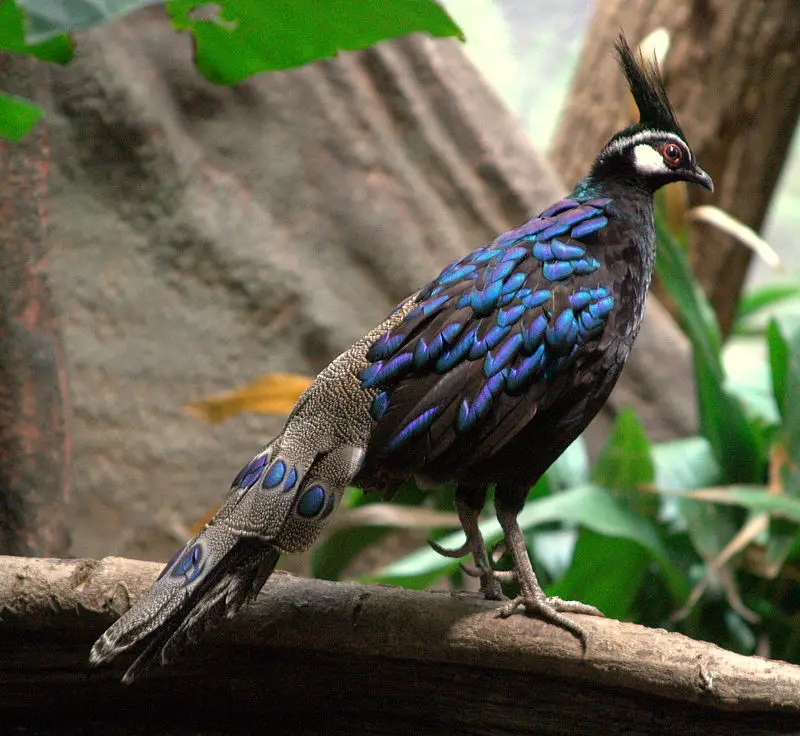
This striking bird, endemic to Palawan Island in the Philippines, captivates with its brilliant plumage.
Males display black feathers, adorned with iridescent blue eye-like patterns on their tails. Meanwhile, females boast a more muted brown appearance.
This medium-sized creature thrives in humid lowland forests below 1,000 meters, yet faces vulnerability due to habitat loss. With a population between 20,000 and 49,999, conservation efforts are crucial.
Scientific classification:
| Kingdom | Animalia |
| Phylum | Chordata |
| Class | Aves |
| Order | Galliformes |
| Family | Phasianidae |
| Genus | Polyplectron |
| Species | P. napoleonis |
Also Featured In: Common Philippines Birds, Palawan Island Birds
2. Rufous Hornbill
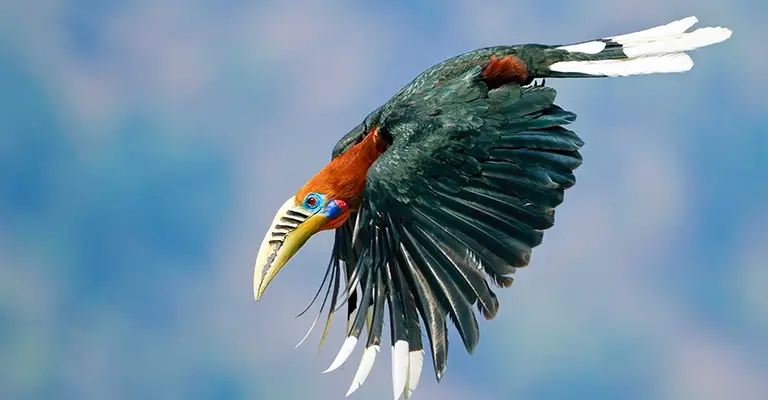
The Rufous Hornbill, or Philippine hornbill, stands as the largest hornbill species in the Philippines.
Known locally as “the clock of the mountains,” it makes resonant calls audible over 1.5 kilometers.
Displaying dark plumage and a red casque, this species inhabits moist tropical lowland forests. Unfortunately, it’s Vulnerable due to poaching and habitat destruction. Conservation efforts remain crucial for its survival.
Scientific classification:
| Kingdom | Animalia |
| Phylum | Chordata |
| Class | Aves |
| Order | Bucerotiformes |
| Family | Bucerotidae |
| Genus | Buceros |
| Species | B. hydrocorax |
Also Featured In: Siargao Island Birds You Didn’t Know,
3. Red-Vented Cockatoo
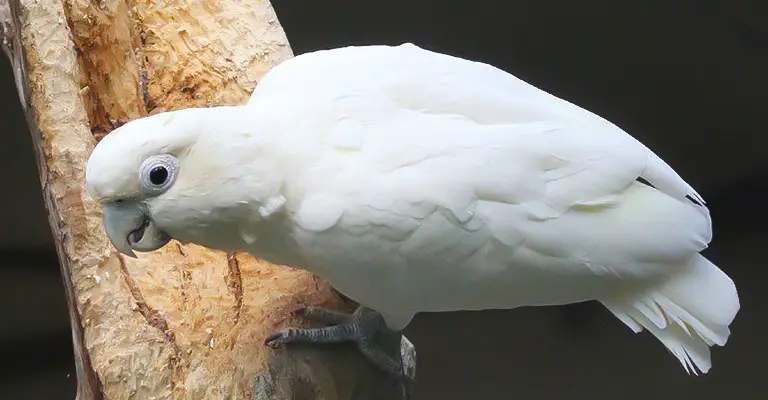
The Red Vented Cockatoo, also called the Philippine cockatoo, is critically endangered. Its striking white plumage features distinctive red undertail coverts.
Found only in the Philippines, it primarily resides in Palawan and Rasa Island. With a population between 430 and 750 individuals, habitat loss and illegal trapping pose significant threats.
Conservation is vital since they breed slowly, reaching maturity at seven years and laying only two to three eggs.
Scientific classification:
| Kingdom | Animalia |
| Phylum | Chordata |
| Class | Aves |
| Order | Psittaciformes |
| Family | Cacatuidae |
| Genus | Cacatua |
| Subgenus | Licmetis |
| Species | C. haematuropygia |
4. Philippine Falconet
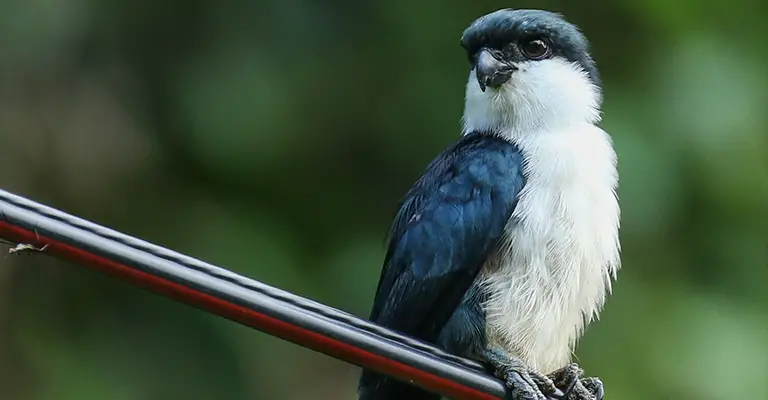
The Philippine Falconet, a small bird of prey, is exclusive to the Philippines. Measuring 15 to 18 cm with a wingspan of 32 to 37 cm, it sports black upperparts contrasting its white underparts
This bird thrives in lowland forests and edges, hunting flying insects. It nests in woodpecker holes, often foraging in pairs. While habitat loss threatens their numbers, they maintain a Least Concern status globally.
Scientific classification:
| Kingdom | Animalia |
| Phylum | Chordata |
| Class | Aves |
| Order | Falconiformes |
| Family | Falconidae |
| Genus | Microhierax |
| Species | M. erythrogenys |
5. Scale-Feathered Malkoha
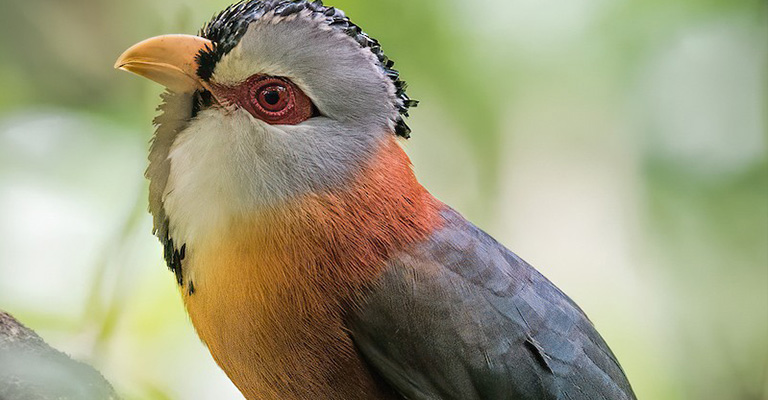
The scale feathered malkoha is endemic to the Philippines and found on Luzon, Catanduanes, and Marinduque. It features glossy black wings, a rufous underbelly, and a striking white hood with scaled feathers.
At 40 cm in length, the bird displays a yellow bill and red eye skin. They forage in tropical moist forests, primarily eating insects like caterpillars. Although labeled as Least Concern, habitat destruction poses a threat.
Scientific classification:
| Kingdom | Animalia |
| Phylum | Chordata |
| Class | Aves |
| Order | Cuculiformes |
| Family | Cuculidae |
| Genus | Dasylophus |
| Species | D. cumingi |
6. Philippine Duck
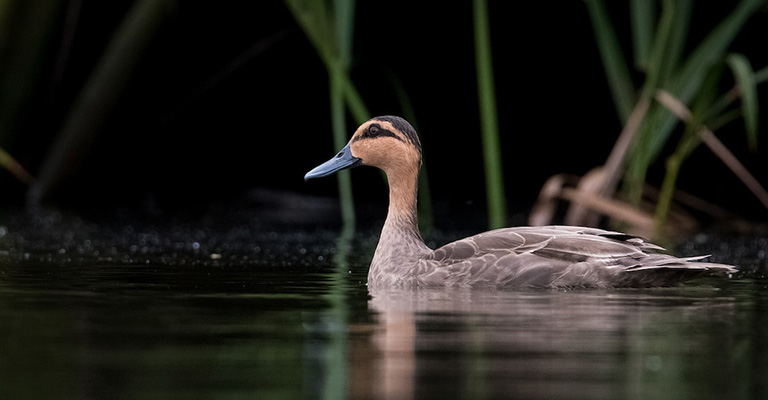
The Philippine Duck, or papan, thrives across Luzon and Mindanao’s wetlands. This dabbling duck sports a black crown, eye stripe, and cinnamon head.
It relies on shrimp, fish, and insects for sustenance. With only 3,300 to 6,700 individuals left, its Vulnerable status stems from hunting and habitat loss. Vital conservation efforts aim to preserve this endemic Philippine species.
Scientific classification:
| Kingdom | Animalia |
| Phylum | Chordata |
| Class | Aves |
| Order | Anseriformes |
| Family | Anatidae |
| Genus | Anas |
| Species | A. luzonica |
7. Philippine Serpent Eagle
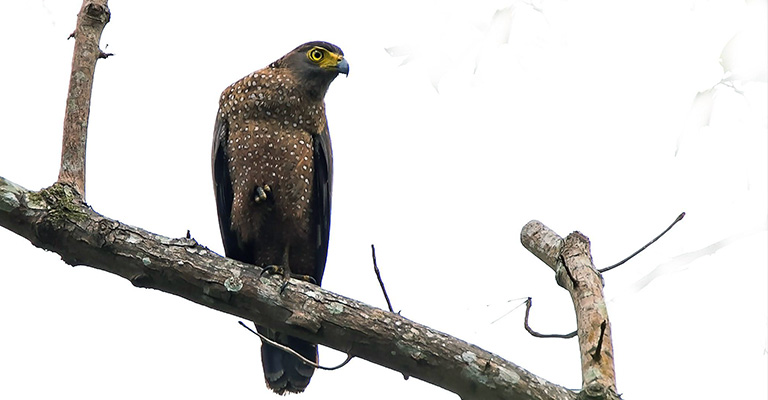
The Philippine Serpent Eagle dominates the forests across the Philippines, excluding Palawan. With dark brown plumage and striking white speckles, it soars high up to 2,500 meters. This raptor feeds on amphibians and reptiles.
Despite its Least Concern status, habitat destruction in forests and woodlands threatens it. Slash-and-burn farming, illegal logging, and hunting remain the primary dangers. Sustained conservation efforts can protect its declining population.
Scientific classification:
| Kingdom | Animalia |
| Phylum | Chordata |
| Class | Aves |
| Order | Accipitriformes |
| Family | Accipitridae |
| Genus | Spilornis |
| Species | S. holospilus |
8. Olive-Backed Sunbird
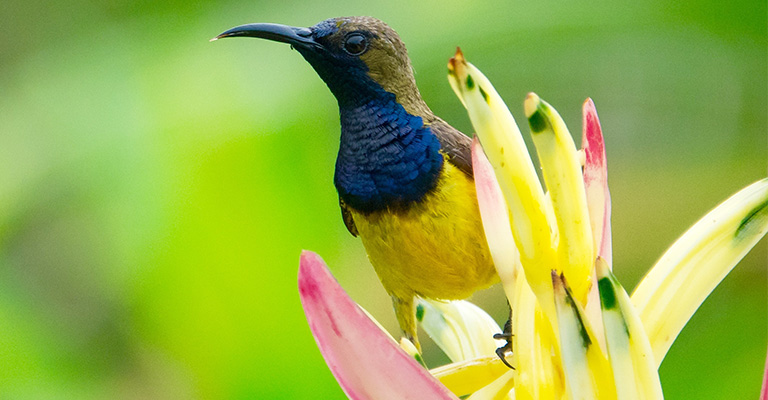
The Olive Backed Sunbird, native to areas from Southeast Asia to Australia, measures approximately 10 to 12 cm.
Males boast a striking blue-black throat accompanied by bright yellow underparts. Females display olive-green above with yellowish underparts.
Feeding primarily on nectar, they use long, curved bills to access flowers and also consume insects. Although categorized as Least Concern by the IUCN, habitat loss due to urbanization and agriculture threatens their population.
Scientific classification:
| Kingdom | Animalia |
| Phylum | Chordata |
| Class | Aves |
| Order | Passeriformes |
| Family | Nectariniidae |
| Genus | Cinnyris |
| Species | C. jugularis |
Also Featured In: Queensland Birds You Should Know, Birds of Far North Queensland
9. Collared Kingfisher
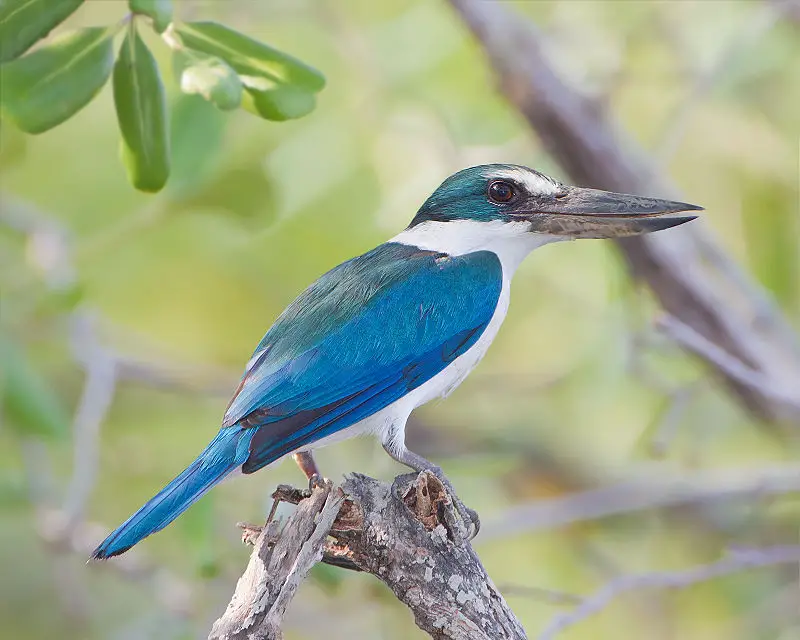
The Collared Kingfisher, known for its striking blue-green plumage and white collar, thrives in coastal regions of Asia, Australia, and Pacific islands.
It measures between 22 and 29 cm in length. This kingfisher hunts by perching quietly and then swooping to catch prey like crabs and insects.
Its population is stable, though habitat loss poses threats. As it’s classified as Least Concern, ongoing monitoring remains important.
Scientific classification:
| Kingdom | Animalia |
| Phylum | Chordata |
| Class | Aves |
| Order | Coraciiformes |
| Family | Alcedinidae |
| Subfamily | Halcyoninae |
| Genus | Todiramphus |
| Species | T. chloris |
Also Featured In: Birds of Goa, Beautiful Birds Found in Coron Island
10. Frogmouth
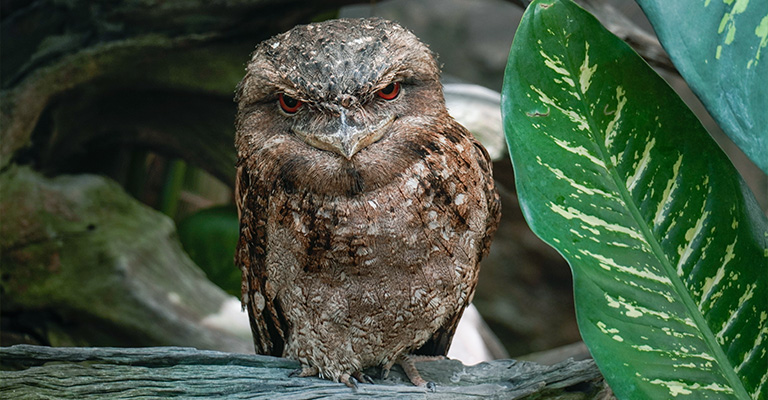
The Frogmouth, part of the Podargidae family, intrigues with its unique appearance and behaviors. They possess broad, frog-like mouths and mottled feathers that offer excellent camouflage.
Found in Southeast Asia, Australia, and the Pacific Islands, these nocturnal birds span 10 to 22 inches in length.
They feed primarily on large insects and small lizards. Notable species like the Tawny Frogmouth build simple twig nests and hunt at night, adding to their allure.
Scientific classification:
| Kingdom | Animalia |
| Phylum | Chordata |
| Class | Aves |
| Clade | Strisores |
| Order | Podargiformes Matthews, 1918 |
| Family | Podargidae Gray, 1847 |
Also Featured In: Asian Birds, Birds that Charles Darwin Studied
11. Pittas
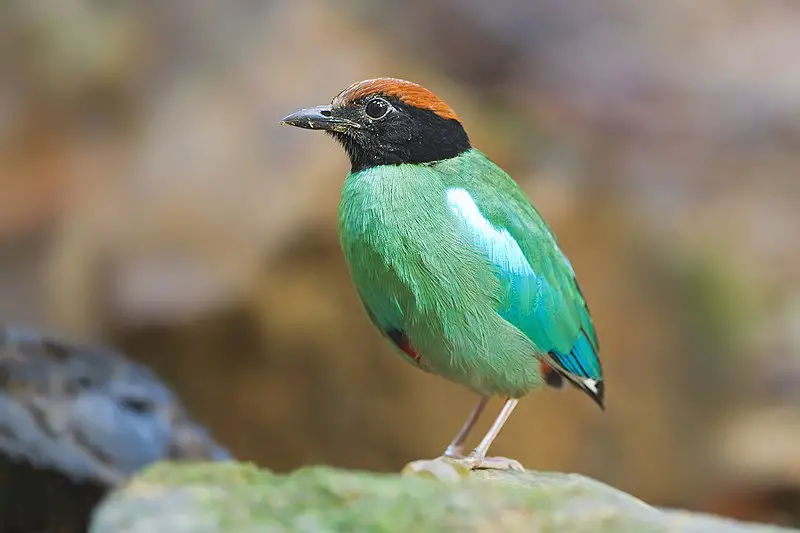
Pittas captivate with their plumage, showcasing hues like blue and green, perfect for blending into their forest habitats.
Found mainly in tropical Asia, Australasia, and Africa, these birds echo the lush beauty found in the Philippines.
They possess stout bodies, measuring 15 to 25 cm, and are mostly terrestrial, preferring forest floors for foraging. Habitat loss threatens their existence, highlighting the need for urgent conservation.
Scientific classification:
| Kingdom | Animalia |
| Phylum | Chordata |
| Class | Aves |
| Order | Passeriformes |
| Suborder | Tyranni |
| Infraorder | Eurylaimides |
| Superfamily | Pittoidea |
| Family | Pittidae Authority disputed.[a] |
Also Featured In: Most Common Taiwan Birds, Birds that Live in Borneo Island
12. Philippine Trogon
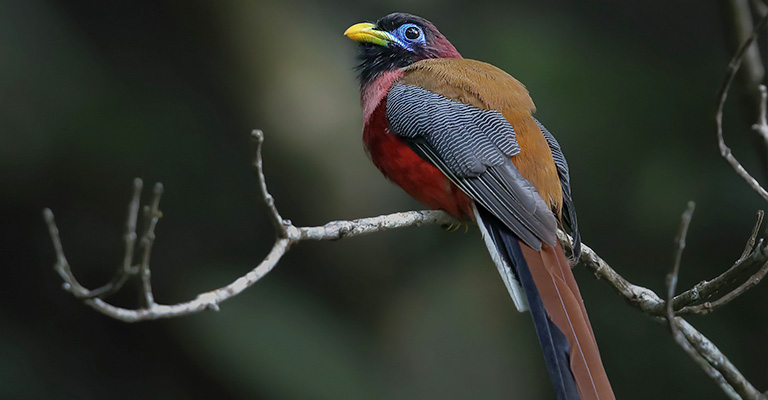
The Philippine Trogon (Harpactes ardens) inhabits the lush forests of Luzon, Mindanao and the Eastern Visayas.
Exhibiting sexual dimorphism, males have a distinct black head and red belly, while females sport a mustard-yellow underbelly.
Measuring about 30 cm, they primarily consume insects like orthopterans. This bird, though classed as Least Concern, faces threats from habitat loss and hunting, emphasizing conservation needs.
Scientific classification:
| Kingdom | Animalia |
| Phylum | Chordata |
| Class | Aves |
| Order | Trogoniformes |
| Family | Trogonidae |
| Genus | Harpactes |
| Species | H. ardens |
Also Featured In: Mindanao Birds You Should Know,
13. Philippine Megapode
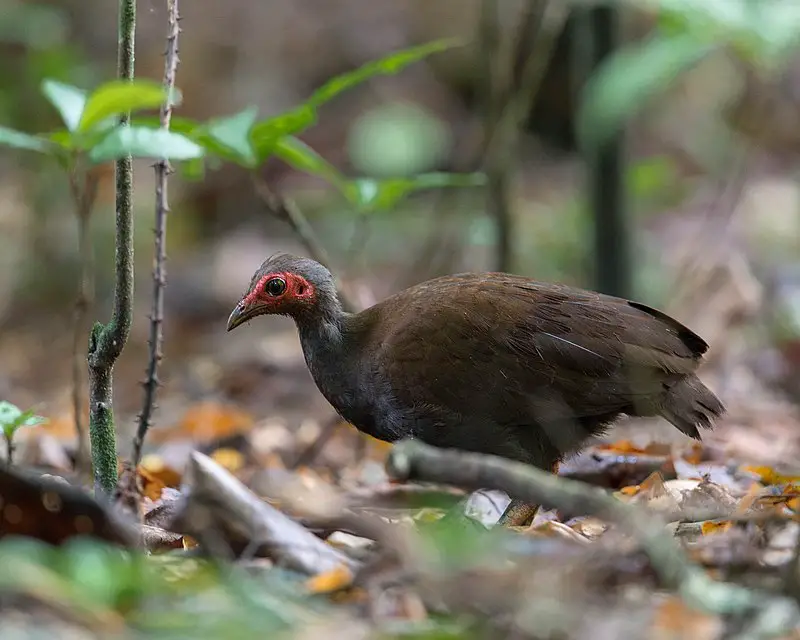
The Philippine Megapode belongs to the unique birds of the Philippines, endemic to various tropical forests.
Measuring about 30 cm, this medium-sized bird features a stunted head, brown wings, and gray underparts.
They primarily forage on the ground, consuming insects, larvae, and fallen fruits. Their declining population stems from habitat loss and predation. Conservation is critical to address threats like human activities, including egg collection and hunting.
Scientific classification:
| Kingdom | Animalia |
| Phylum | Chordata |
| Class | Aves |
| Order | Galliformes |
| Family | Megapodiidae |
| Genus | Megapodius |
| Species | M. cumingii |
Also Featured In: Mindoro Birds You Should Know, Most Common Catanduanes Birds
14. Pied Triller
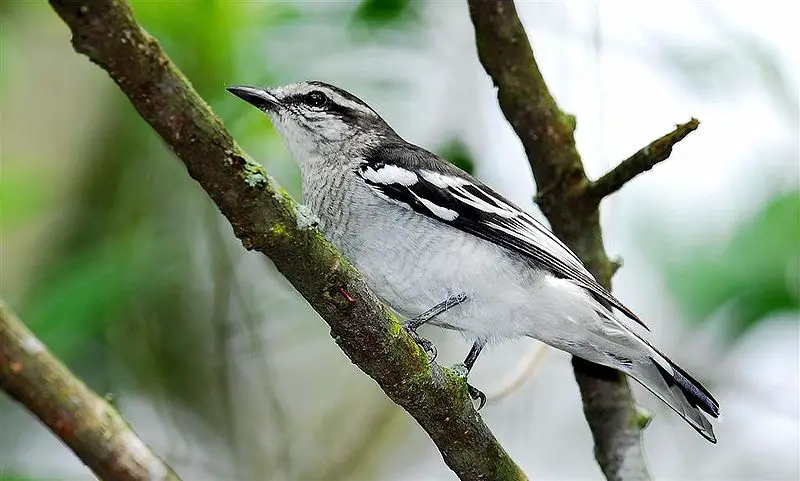
The Pied Triller (Lalage nigra) stands out in Southeast Asia, especially in the Philippines. Featuring distinctive black and white plumage, males have a white brow and extensive wing patches.
Females and juveniles adopt more subdued gray-brown tones. It’s known for making nasal “checka-checkuh” and rapid rattling calls.
Insects and fruits are its primary diet. Habitat loss, though not an immediate threat, poses a potential risk.
Scientific classification:
| Kingdom | Animalia |
| Phylum | Chordata |
| Class | Aves |
| Order | Passeriformes |
| Family | Campephagidae |
| Genus | Lalage |
| Species | L. nigra |
Also Featured In: Birds that Live in Kuala Lumpur, HDB Approved by Birds
15. Blue-Tailed Bee-Eater
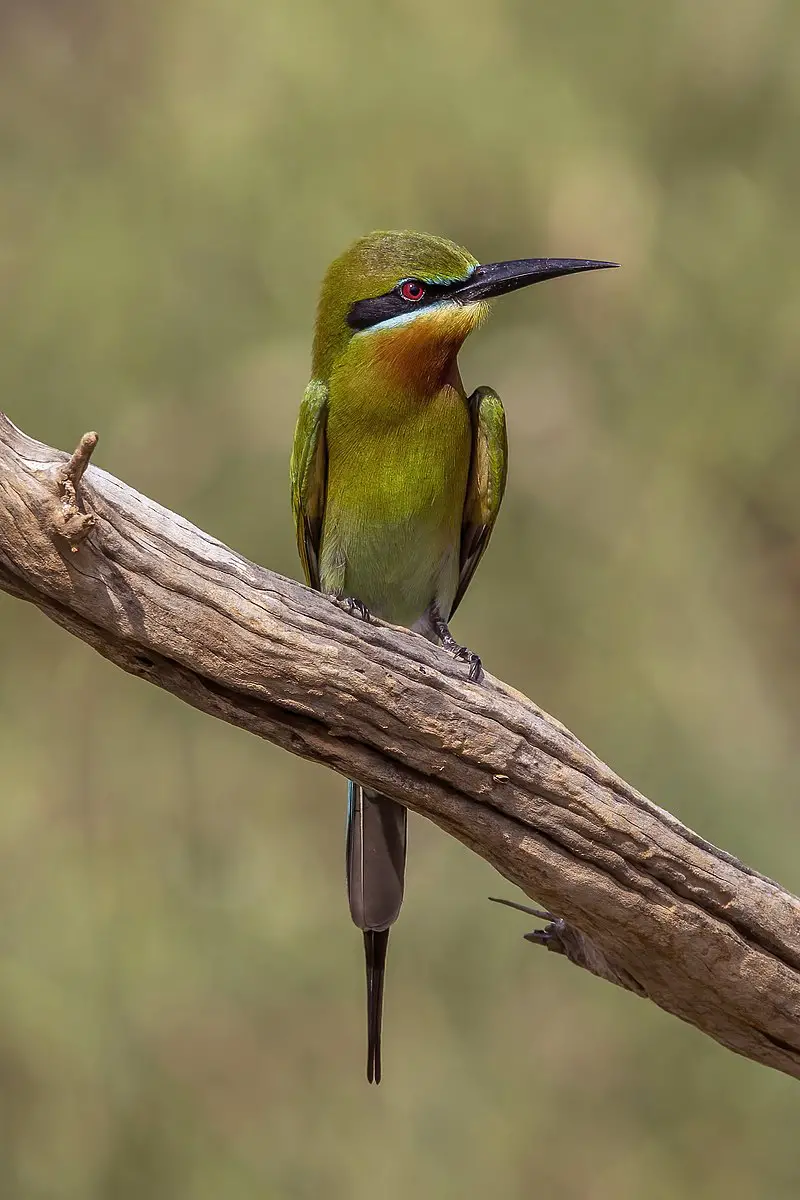
The Blue Tailed Bee Eater, Merops philippinus, captivates with its green feathers and striking blue tail. This bird, 23 to 26 cm long, thrives across South and Southeast Asia, especially in open habitats near water.
It excels at aerial hunting, capturing insects like dragonflies and bees. Although classified as Least Concern, habitat loss remains a threat to its wide populations.
Scientific classification:
| Kingdom | Animalia |
| Phylum | Chordata |
| Class | Aves |
| Order | Coraciiformes |
| Family | Meropidae |
| Genus | Merops |
| Species | M. philippinus |
Also Featured In: Common Birds in Kerala, Birds of Karnataka
16. Pacific Reef Heron
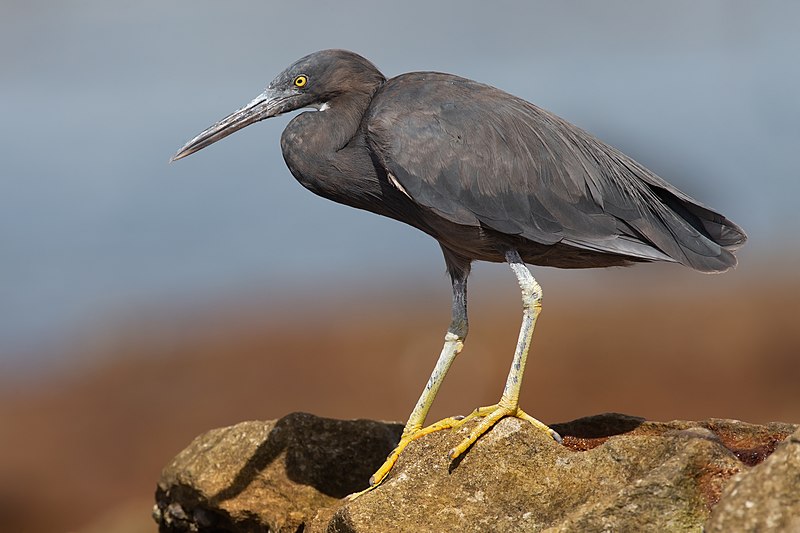
The Pacific Reef Heron spans 57 to 66 cm with wings reaching 90 to 110 cm. Known for haunting rocky shores and reefs, this heron often stands still with open wings to shade and attract prey like fish and crustaceans.
Found across southern Asia and Oceania, they come in slaty grey or pure white morphs, but the grey is more common. Despite being Least Concern, habitat threats exist.
Scientific classification:
| Kingdom | Animalia |
| Phylum | Chordata |
| Class | Aves |
| Order | Pelecaniformes |
| Family | Ardeidae |
| Genus | Egretta |
| Species | E. sacra |
Also Featured In: Common Republic of Nauru Birds, Birds of Hyōgo
17. Chinese Sparrowhawk
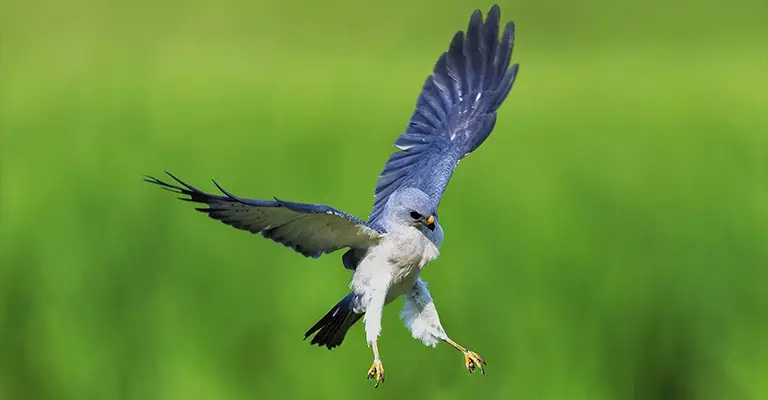
The Chinese Sparrowhawk, known as Accipiter soloensis, is a small raptor found in the Philippines during the winter months.
Measuring 30 to 36 cm, it’s notable for sexual dimorphism, with males smaller than females. Awake and vigilant, males have red eyes, while females display yellow ones.
Typically residing in wooded areas, the sparrowhawk relies on agile flight to hunt small birds and insects. Despite experiencing habitat loss, the species’ stable population earns it a Least Concern status.
Scientific classification:
| Kingdom | Animalia |
| Phylum | Chordata |
| Class | Aves |
| Order | Accipitriformes |
| Family | Accipitridae |
| Genus | Accipiter |
| Species | A. soloensis |
18. Yellow-Breasted Fruit Dove
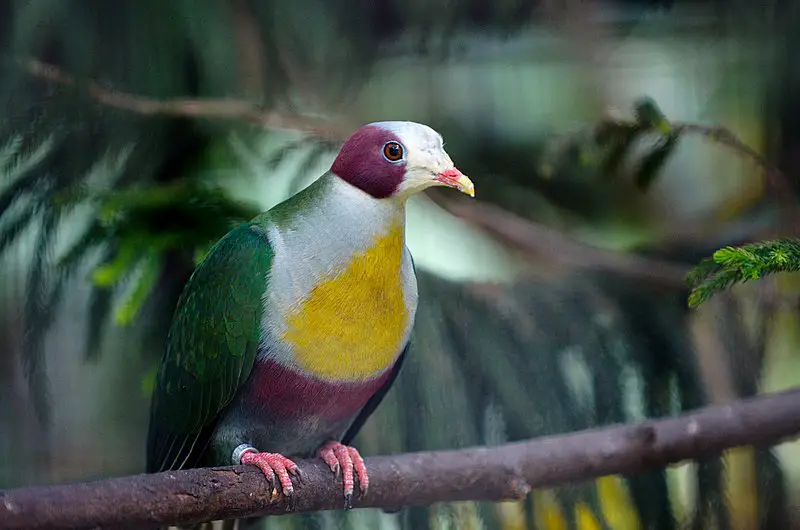
The Yellow Breasted Fruit Dove, locally called balorinay, is a vivid species endemic to the Philippines. It is easily recognized by its green upperparts and yellow breast.
This medium-sized dove thrives in tropical moist lowland forests. Typically, it inhabits elevations up to 1,800 meters and prefers feeding on fruits.
Despite being classified as Least Concern, its decline stems from habitat loss, hunting, and trapping, emphasizing the need for protective measures.
Scientific classification:
| Kingdom | Animalia |
| Phylum | Chordata |
| Class | Aves |
| Order | Columbiformes |
| Family | Columbidae |
| Genus | Ptilinopus |
| Species | P. occipitalis |
Also Featured In: Most Common Birds in Negros,
19. Shorebirds
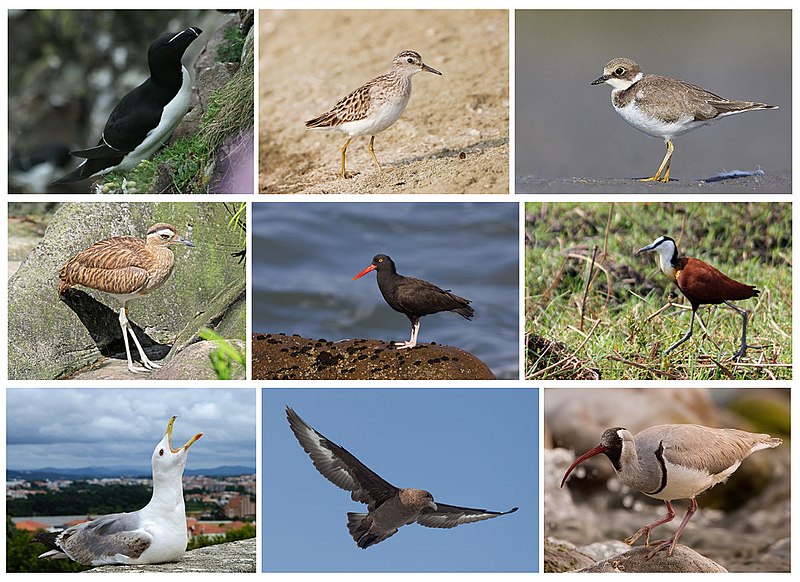
Shorebirds in the Philippines showcase incredible biodiversity with species like sandpipers and curlews. They rely on coastal habitats for breeding, feeding, and migrating.
Populations are declining due to habitat loss and environmental changes. Protecting these birds is critical, with over 217 species worldwide needing conservation.
Shorebirds play a vital role in maintaining ecological balance in their ecosystems, highlighting the urgency of conservation efforts.
Scientific classification:
| Kingdom | Animalia |
| Phylum | Chordata |
| Class | Aves |
| Infraclass | Neognathae |
| Clade | Neoaves |
| Clade | Gruimorphae |
| Order | Charadriiformes Huxley, 1867 |
20. Zebra Dove
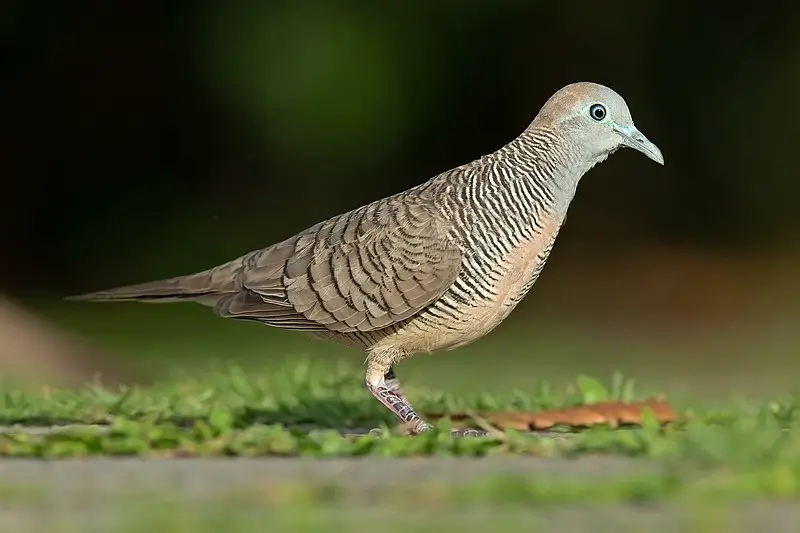
The Zebra Dove, also called the barred ground dove, stands out with grayish brown plumage and dark bars.
It measures 20-23 cm, with a long tail and distinctive blue skin around the eyes. Native to Southeast Asia, this dove adapts well to urban and open habitats. Known for its soft cooing calls, it’s popular as a pet in Thailand and Indonesia.
Scientific classification:
| Kingdom | Animalia |
| Phylum | Chordata |
| Class | Aves |
| Order | Columbiformes |
| Family | Columbidae |
| Genus | Geopelia |
| Species | G. striata |
Also Featured In: Birds of Kauai, Hawaii, Hawaii Big Island Birds You Should Know
21. Leafbird
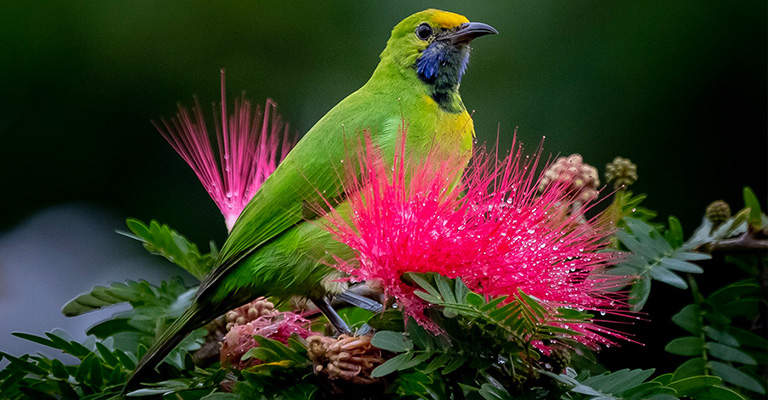
Leafbirds enchant with their bright plumage, displaying vivid greens and yellows. They measure between 14 and 21 cm and thrive in evergreen forests of the Philippines.
These small passerine birds, which include species like the Philippine Leafbird (Chloropsis flavipennis), prefer nesting high in trees and rarely descend below 1,000 meters. Their diet consists mainly of fruits and insects, contributing to their melodious calls.
Scientific classification:
| Kingdom | Animalia |
| Phylum | Chordata |
| Class | Aves |
| Order | Passeriformes |
| Family | Chloropseidae Wetmore, 1960 |
| Genus | Chloropsis Jardine & Selby, 1827 |
Also Featured In: Birds that Found in Sumatra,
22. Bukidnon Woodcock
The Bukidnon Woodcock thrives in the Philippines’ mountainous forests, preferring areas above 1,000 meters. This medium-sized wader features rich reddish brown plumage with black barring.
It relies on its long bill to extract soil invertebrates. Although primarily nocturnal, it produces distinctive calls during display flights.
Habitat loss poses a threat, but its population remains stable. The IUCN classifies it as Least Concern due to its large range.
Scientific classification:
| Kingdom | Animalia |
| Phylum | Chordata |
| Class | Aves |
| Order | Charadriiformes |
| Family | Scolopacidae |
| Genus | Scolopax |
| Species | S. bukidnonensis |
23. Barred Rail
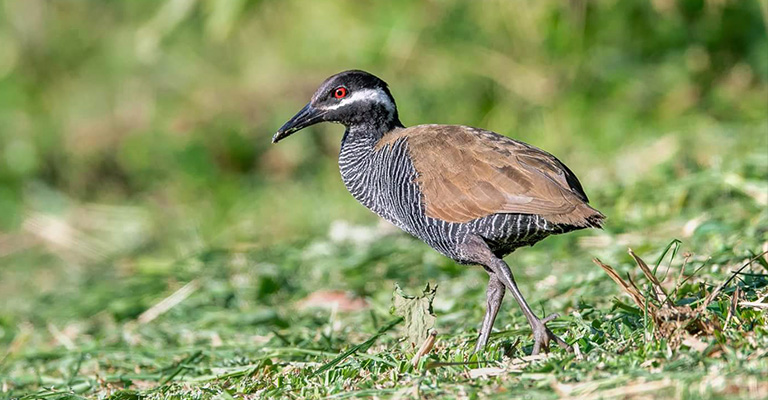
The Barred Rail, or Hypotaenidia torquata, thrives primarily in the Philippines, Sulawesi, and Salawati. This species exhibits shy behavior, making observation challenging despite its prevalence in the habitat.
Dense vegetation and wetlands provide a crucial environment where they forage. Eggs of species like the Philippine megapode form a significant part of their diet.
Although not currently threatened, habitat loss could risk population declines. Conservation efforts are essential for their sustainability.
Scientific classification:
| Kingdom | Animalia |
| Phylum | Chordata |
| Class | Aves |
| Order | Gruiformes |
| Family | Rallidae |
| Genus | Hypotaenidia |
| Species | H. torquata |
24. Apo Myna
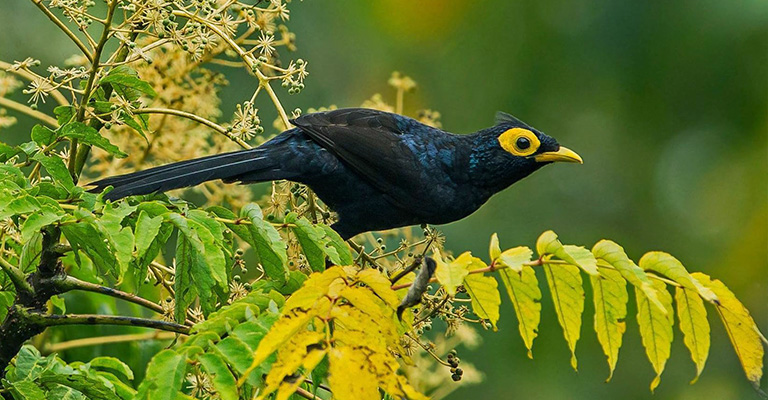
The Apo Myna, Goodfellowia miranda, inhabits the montane forests of the Philippines. Notably found on Mount Apo, it’s distinguished by black and white plumage with a yellow wing patch.
They forage for insects and fruits, aiding in seed dispersal, crucial for ecosystem balance. Despite facing habitat destruction, the species holds a Least Concern status due to stable populations in protected areas.
Scientific classification:
| Kingdom | Animalia |
| Phylum | Chordata |
| Class | Aves |
| Order | Passeriformes |
| Family | Sturnidae |
| Genus | Goodfellowia Hartert, 1903 |
| Species | G. miranda |
25. Philippine Pygmy Woodpecker
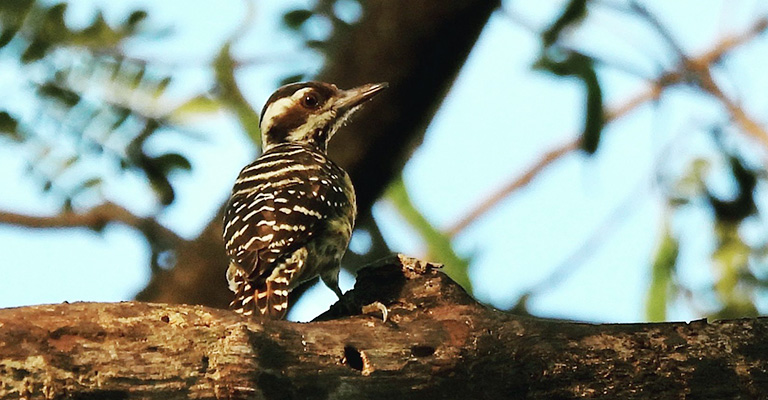
Characterized by dark brown upperparts and white barring, the Philippine pygmy woodpecker thrives across various habitats excluding Sulu Archipelago and Palawan.
Males distinguish themselves with a red patch on the head. Feeding on insects, they often forage in pairs or small groups.
Despite urban expansion, their adaptability helps maintain a stable population. The IUCN lists them as Least Concern, underscoring their resilience.
Scientific classification:
| Kingdom | Animalia |
| Phylum | Chordata |
| Class | Aves |
| Order | Piciformes |
| Family | Picidae |
| Genus | Yungipicus |
| Species | Y. maculatus |
26. Yellow-Vented Bulbul
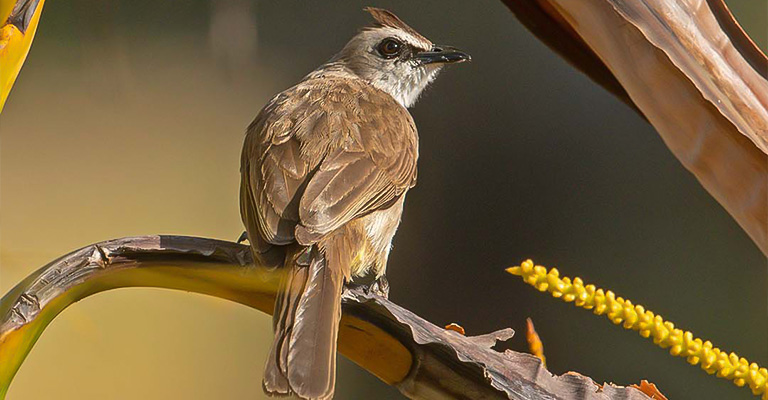
The Yellow Vented Bulbul, known scientifically as Pycnonotus goiavier, thrives throughout Southeast Asia, including the Philippines and Indochina. It typically inhabits open spaces like gardens, evading dense forests.
Its brown upperparts and bright yellow vent make it easily recognizable. This species uses grass and twigs to create nests near human areas.
With a diet of fruits, nectar, and insects, it exhibits versatile foraging. The IUCN classifies it as Least Concern due to a stable population.
Scientific classification:
| Kingdom | Animalia |
| Phylum | Chordata |
| Class | Aves |
| Order | Passeriformes |
| Family | Pycnonotidae |
| Genus | Pycnonotus |
| Species | P. goiavier |
Also Featured In: Birds that Commonly Found in Bali, Native Birds Of Ko Chang District
27. Writhed Hornbill
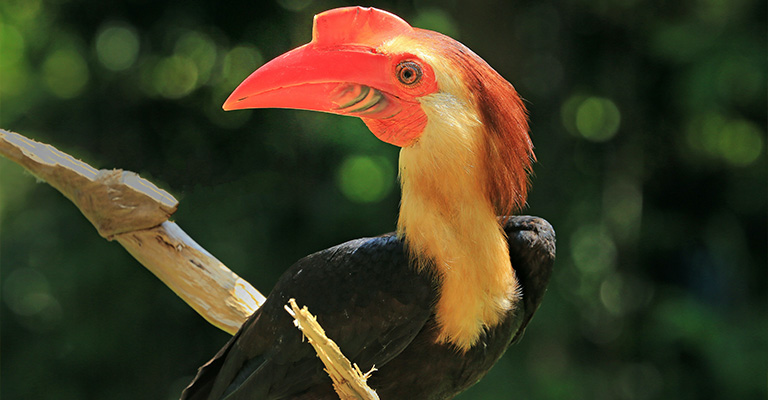
The Writhed Hornbill, Rhabdotorrhinus leucocephalus, thrives in the lowland forests of Mindanao, Dinagat, and Camiguin. Exhibiting a striking appearance with predominantly black plumage, it features a distinctive red bill with ridges.
Males display an orange chest and neck while females have a black neck and head. It mainly feeds on fruits, also consuming insects and small vertebrates.
Classified as Near Threatened by the IUCN, habitat loss and hunting pressures contribute to its population decline.
Scientific classification:
| Kingdom | Animalia |
| Phylum | Chordata |
| Class | Aves |
| Order | Bucerotiformes |
| Family | Bucerotidae |
| Genus | Rhabdotorrhinus |
| Species | R. leucocephalus |
28. Black-Naped Oriole
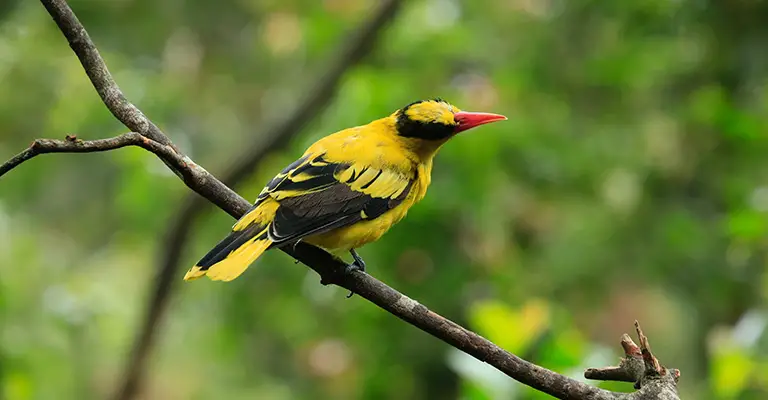
The Black Naped Oriole graces the forests of Asia, including the Philippines. This striking bird captivates with its yellow plumage and distinctive black nape.
Measuring around 27 cm, males flaunt bright yellow feathers with black wings, while females appear more olive-green.
They thrive in diverse environments, from forests to plantations. During breeding season, from January to July, their melodious calls fill the air.
Scientific classification:
| Kingdom | Animalia |
| Phylum | Chordata |
| Class | Aves |
| Order | Passeriformes |
| Family | Oriolidae |
| Genus | Oriolus |
| Species | O. chinensis |
Also Featured In: Hong Kong Birds You Need to See,
29. Calayan Rail
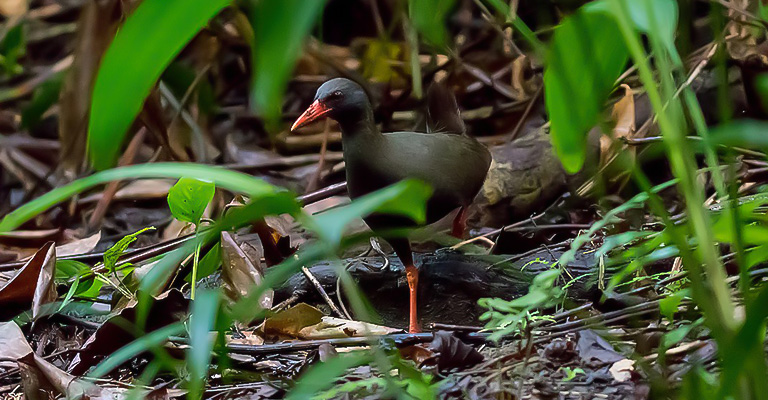
The Calayan Rail inhabits Calayan Island in the Philippines, where it thrives in its forest habitat. Discovered in 2004, this flightless bird showcases slaty gray plumage and a distinctive blackish face. Its orange-red legs and bills add to its striking appearance.
It primarily scavenges the forest floor, dining on snails, beetles, and millipedes. With a population of 2,500 to 4,300 individuals, its status is Vulnerable due to habitat loss and predation. Conservation efforts focus on habitat protection and community awareness.
Scientific classification:
| Kingdom | Animalia |
| Phylum | Chordata |
| Class | Aves |
| Order | Gruiformes |
| Family | Rallidae |
| Genus | Aptenorallus Kirchman, McInerney, Giarla, Olson, Slikas, and Fleischer, 2021 |
| Species | A. calayanensis |
30. Pink-Necked Green Pigeon
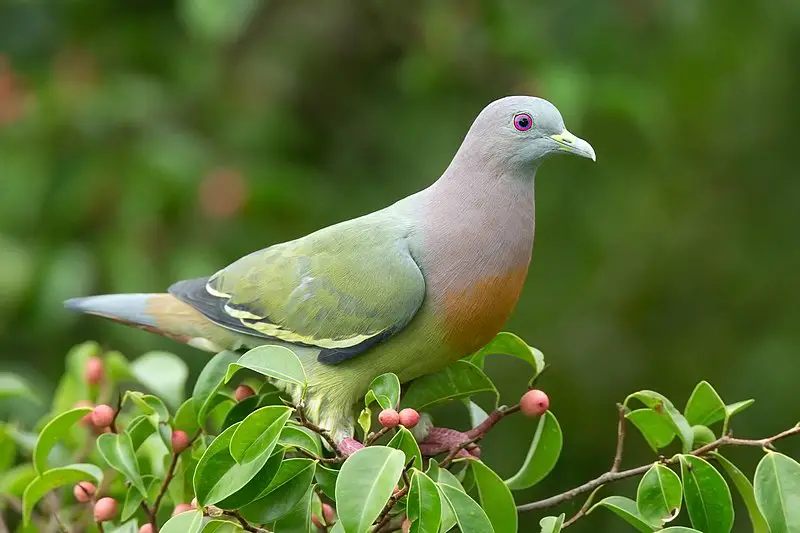
The Pink Necke Green Pigeon, Treron vernans, thrives across Southeast Asia. This medium-sized bird measures 25 to 30 cm in length. Males showcase pink necks, while females have muted colors.
Thriving in forests, gardens, and urban areas, they feed primarily on fruits, including figs. Their gregarious nature often leads them to roost in flocks.
The species plays a crucial role in seed dispersal and holds a Least Concern status due to adaptability and stable populations.
Scientific classification:
| Kingdom | Animalia |
| Phylum | Chordata |
| Class | Aves |
| Order | Columbiformes |
| Family | Columbidae |
| Genus | Treron |
| Species | T. vernans |
Also Featured In: Samar Island Birds You Should Know, Birds That Live In Siquijor
31. Besra
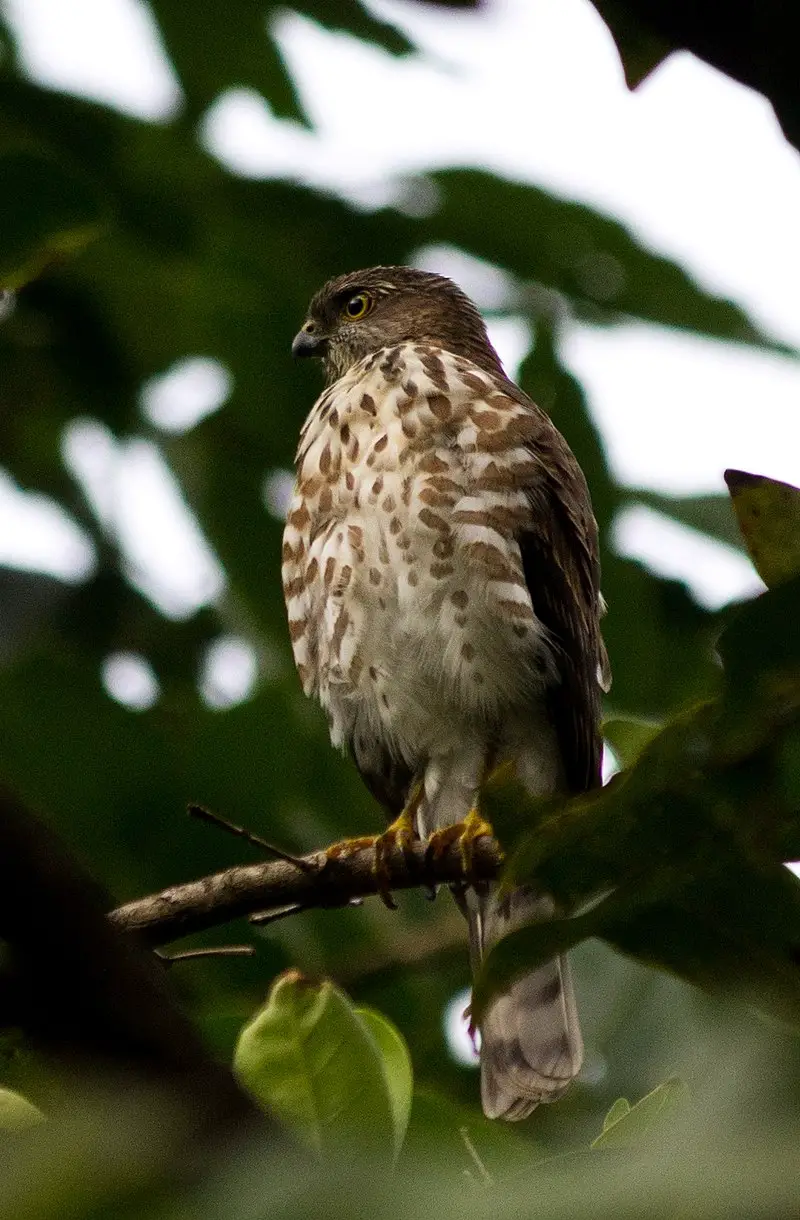
The Besra, or Tachyspiza virgata, belongs to the Accipitridae family. This medium-sized raptor thrives in dense forests from India to Southeast Asia.
A length of 29 to 36 cm, paired with short broad wings and a long tail, allows it to maneuver through woodlands.
Males show dark blue-gray upperparts contrasting with barred underparts, while females exhibit browner tones.
This bird of prey surprises its targets, which include small birds and lizards, by emerging from hidden perches. The species is categorized as Least Concern due to its adaptability and widespread distribution.
Scientific classification:
| Kingdom | Animalia |
| Phylum | Chordata |
| Class | Aves |
| Order | Accipitriformes |
| Family | Accipitridae |
| Genus | Accipiter |
| Species | A. virgatus |
32. Luzon Bleeding-Heart
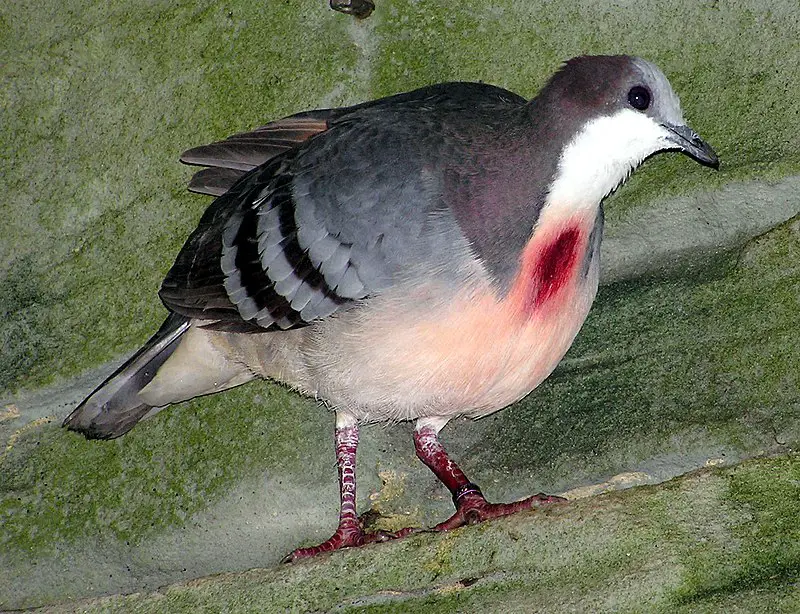
The Luzon Bleeding-Heart is a dove endemic to the Philippines, mainly seen on Luzon and Polillo islands. Its distinctive red chest patch, surrounded by lighter feathers, resembles a bleeding wound.
With a length of 30 cm, it has slate gray upperparts and white underparts. These doves inhabit primary and secondary forests, foraging for seeds, berries, and insects.
Their shy nature keeps them hidden among foliage. Breeding occurs in May, laying two eggs. Conservation efforts are vital due to threats from habitat loss and the pet trade.
Scientific classification:
| Kingdom | Animalia |
| Phylum | Chordata |
| Class | Aves |
| Order | Columbiformes |
| Family | Columbidae |
| Genus | Gallicolumba |
| Species | G. luzonica |
33. Philippine Hanging Parrot
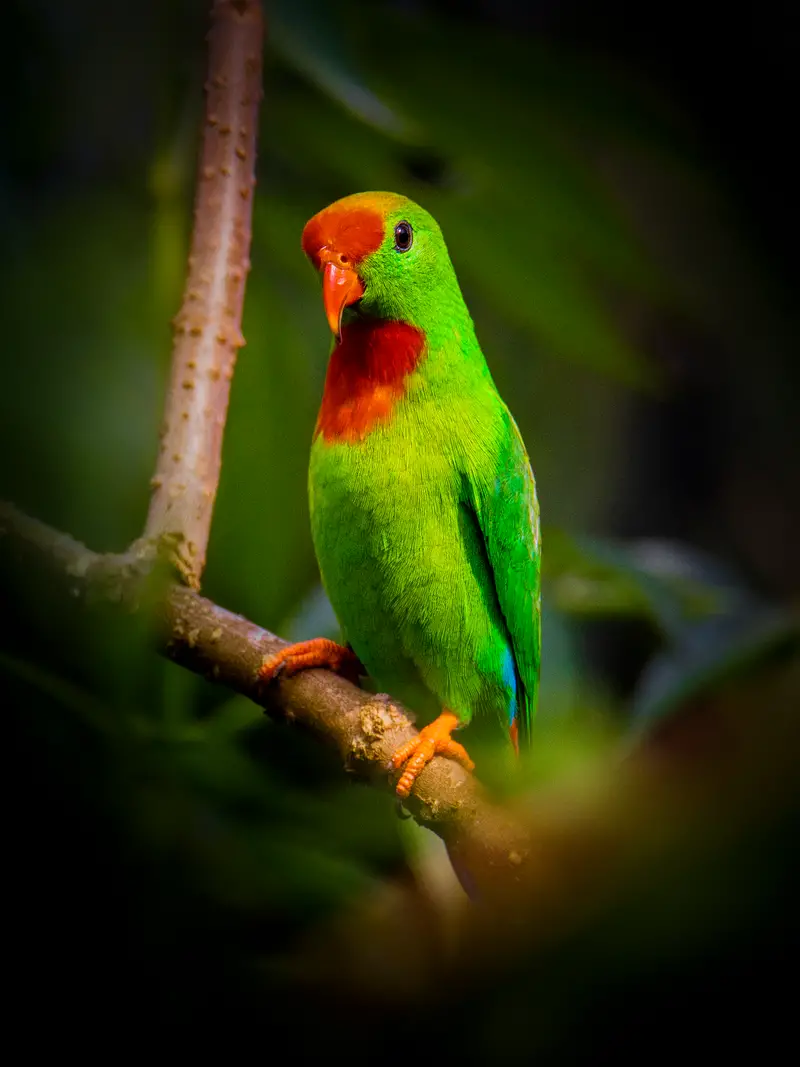
The Philippine Hanging Parrot, or colasisi, has a green plumage accented with red, orange, and blue hues. Locally, it is renowned for its colorful appearance.
Females differ from males, lacking the distinct red breast patch males have, adding another layer of identification.
These small parrots feed primarily on nectar and soft fruits like figs. In their unique nesting behavior, females gather materials to line tree cavities.
Scientific classification:
| Kingdom | Animalia |
| Phylum | Chordata |
| Class | Aves |
| Order | Psittaciformes |
| Family | Psittaculidae |
| Genus | Loriculus |
| Species | L. philippensis |
34. Mindanao Hornbill
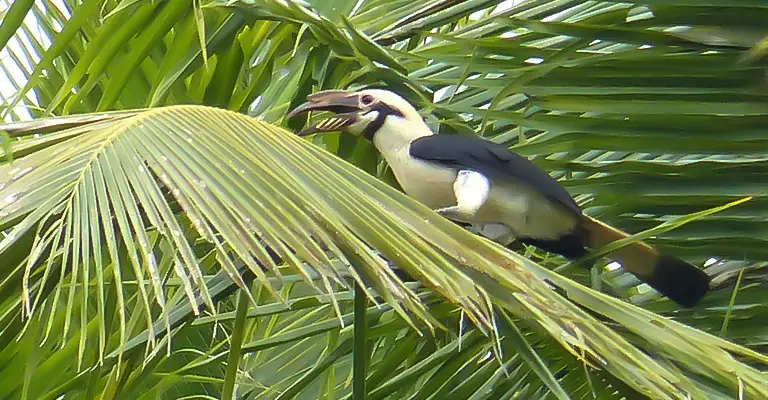
Mindanao Hornbill, or Mindanao Tarictic Hornbill, is endemic to the Philippines’ rainforests, especially in Mindanao, Dinagat, Siargao, and Basilan.
With its creamy white head, underparts, and blue facial skin, it stands out. Primarily inhabiting forests up to 900 meters, it feeds on fruits, seeds, insects, and small reptiles.
Despite its Least Concern status, habitat destruction from logging and agriculture threatens its survival. Conservation efforts are crucial.
Scientific classification:
| Kingdom | Animalia |
| Phylum | Chordata |
| Class | Aves |
| Order | Bucerotiformes |
| Family | Bucerotidae |
| Genus | Penelopides |
| Species | P. affinis |
35. Chestnut-Breasted Malkoha
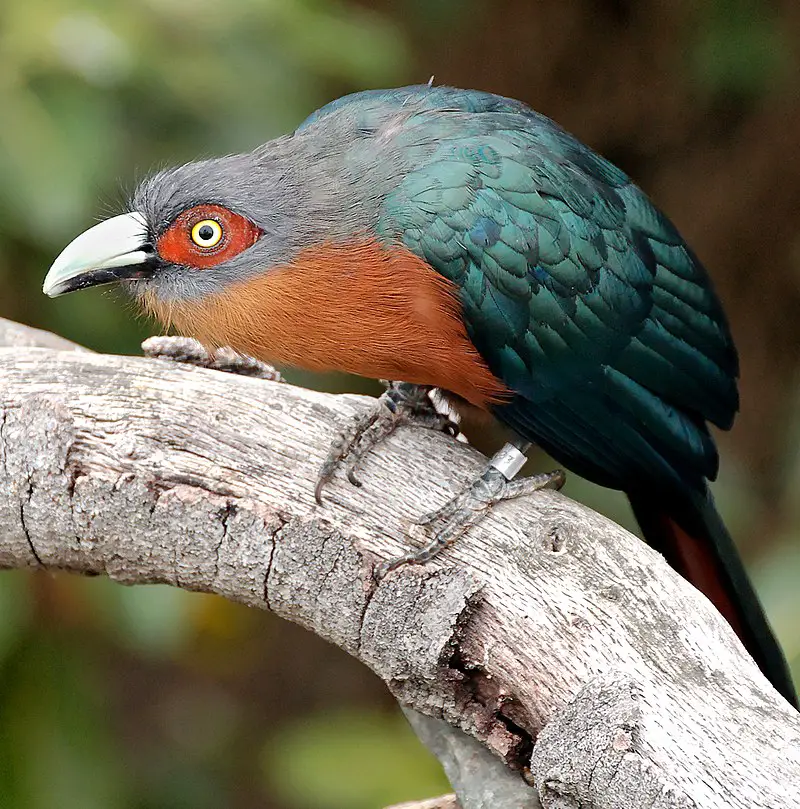
The Chestnut-Breasted Malkoha, a unique bird endemic to the Philippines, thrives in Luzon’s lush forests and nearby islands.
It enchants birdwatchers with its chestnut-brown breast and glossy greenish-black upperparts. Measuring approximately 35-40 cm, the bird is recognized by its melodious calls.
Primarily arboreal, it forages in dense foliage for insects and fruits. Habitat loss poses a potential threat, despite the IUCN classifying it as Least Concern.
Scientific classification:
| Kingdom | Animalia |
| Phylum | Chordata |
| Class | Aves |
| Order | Cuculiformes |
| Family | Cuculidae |
| Genus | Phaenicophaeus |
| Species | P. curvirostris |
36. Spotted Imperial Pigeon
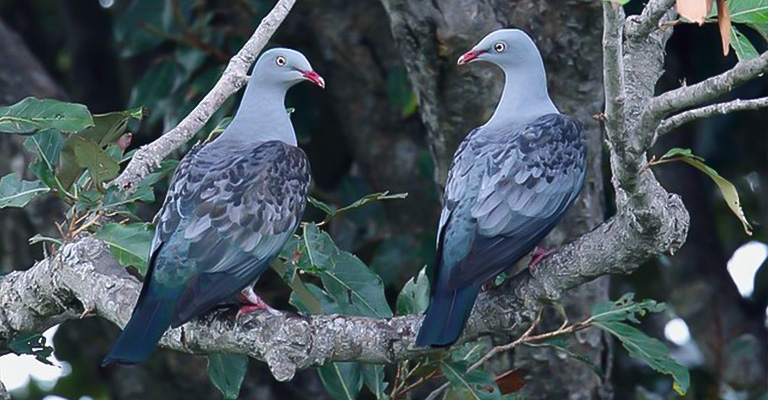
The Spotted Imperial Pigeon, or Ducula carola, graces the Philippines with its presence. Measuring 32 to 38 centimeters, its striking plumage displays ashy gray and dark chestnut hues with creamy throats.
Males are distinct, flaunting a white crescent on the breast. They typically inhabit forest edges, venturing to limestone shorelines.
The population is vulnerable due to habitat loss and hunting, with only 2,500 to 9,999 mature individuals remaining.
Scientific classification:
| Kingdom | Animalia |
| Phylum | Chordata |
| Class | Aves |
| Order | Columbiformes |
| Family | Columbidae |
| Genus | Ducula |
| Species | D. carola |
37. Southern Silvery Kingfisher
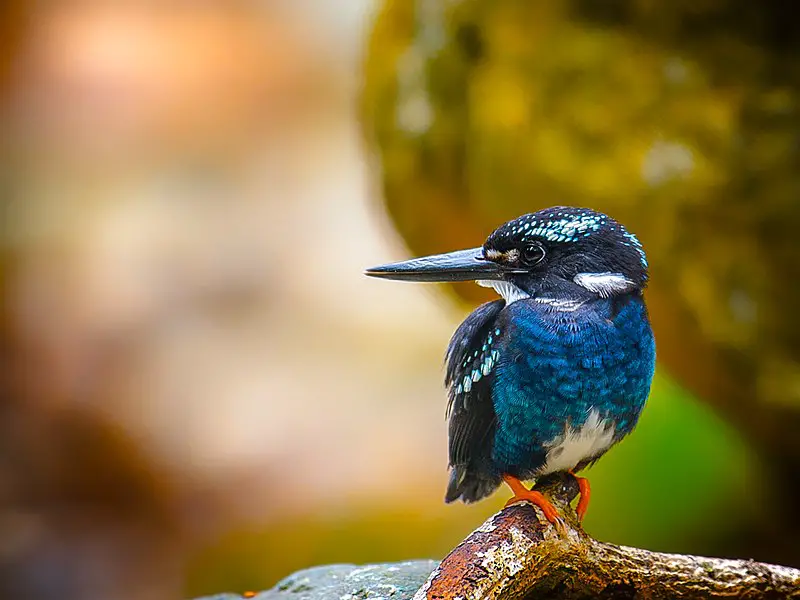
Southern Silvery Kingfisher, or Alcedo argentata, belongs to the Philippines’ unique avifauna. Measuring 15-17 cm, this bird’s blue upperparts and silvery white underparts stand out.
It thrives in lowland forests, favoring habitats with dense vegetation near streams and rivers. Primarily feeding on small fish, insects, and crustaceans, it relies on sharp eyesight for hunting.
Despite being least concern by the IUCN, habitat loss due to deforestation and water pollution threatens its survival.
Scientific classification:
| Kingdom | Animalia |
| Phylum | Chordata |
| Class | Aves |
| Order | Coraciiformes |
| Family | Alcedinidae |
| Subfamily | Alcedininae |
| Genus | Ceyx |
| Species | C. argentatus |
Also Featured In: Silver Birds You Should Know,
38. Chestnut Munia
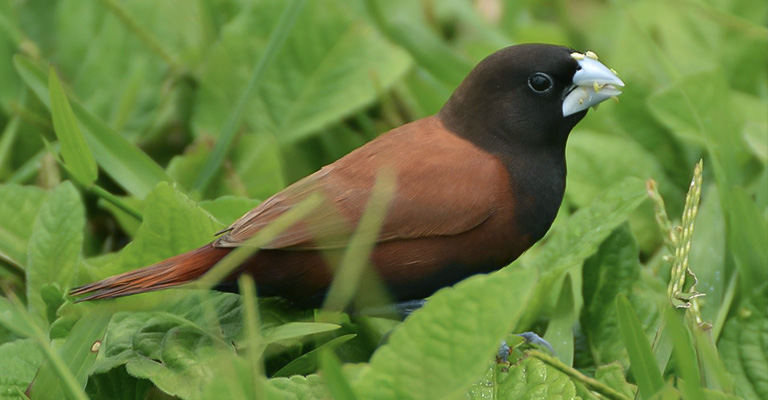
The Chestnut Munia, known as the black-headed munia, is endemic to Southeast Asia, including the Philippines. It measures about 11 to 12 cm in length.
This bird features a striking black head and a chestnut-brown body. It also has a brick red patch on its lower back, visible in flight.
Found in grasslands and agricultural areas, it feeds on seeds and grains. Large domed nests are built from grass, where they lay 4 to 7 white eggs.
Despite losing its status as the national bird in 1995, its population is stable, and it is listed as Least Concern.
Scientific classification:
| Kingdom | Animalia |
| Phylum | Chordata |
| Class | Aves |
| Order | Passeriformes |
| Family | Estrildidae |
| Genus | Lonchura |
| Species | L. atricapilla |
39. Bee-Eater
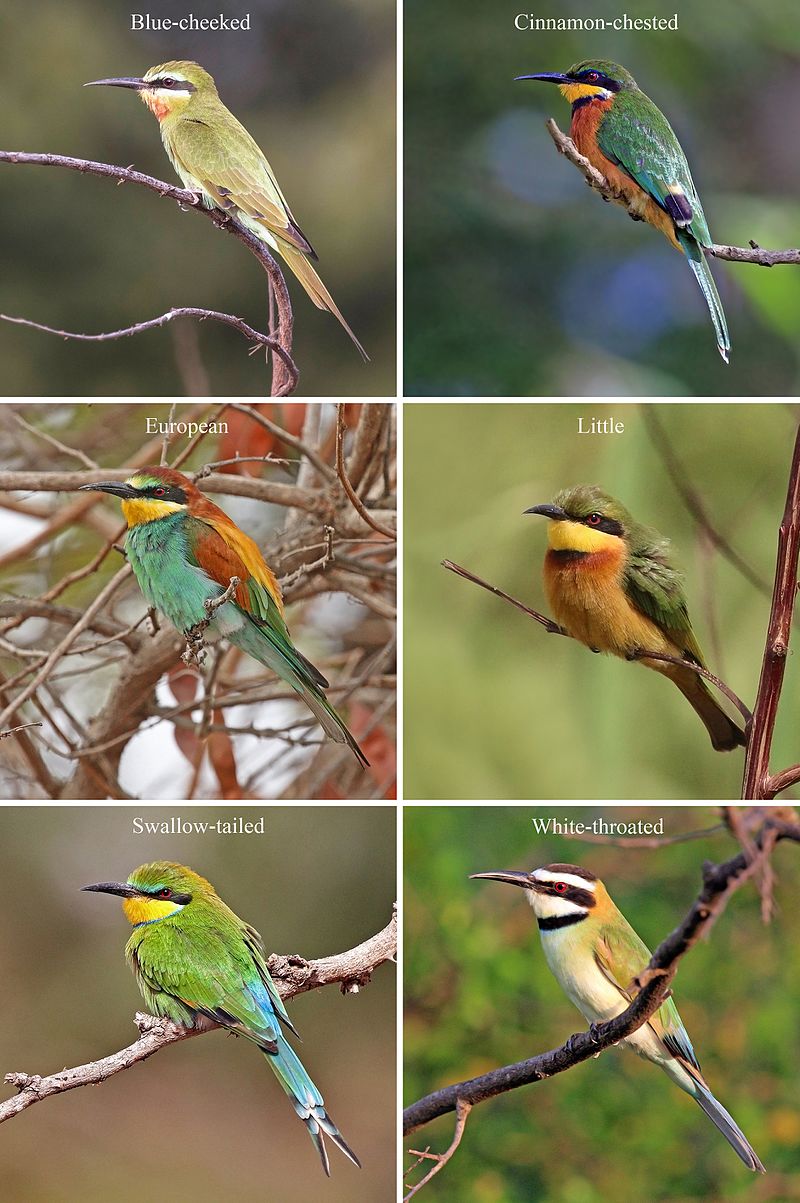
Bee-eaters, belonging to the family Meropidae, display plumage in shades of green, yellow, and blue.
These colorful birds, found mainly in Africa and Asia, consist of approximately 31 species. They excel at catching flying insects like bees and wasps mid-air.
Their unique method of removing stingers involves hitting insects against hard surfaces before consumption. These birds often nest in burrows, laying five to eight eggs.
Scientific classification:
| Kingdom | Animalia |
| Phylum | Chordata |
| Class | Aves |
| Order | Coraciiformes |
| Family | Meropidae Rafinesque, 1815 |
40. Azure-Breasted Pitta
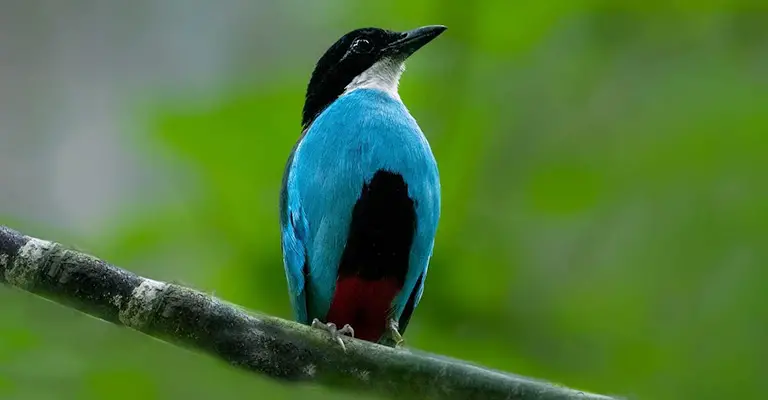
The Azure Breasted Pitta is a striking bird endemic to the Philippines. Found primarily in Mindanao’s dense lowland forests, they inhabit regions near streams or forest edges.
Measuring about 23 centimeters, these medium-sized birds display a deep azure blue crown and wings.
Their diet consists of insects, snails, and small invertebrates, foraging on the forest floor. Endangered by deforestation, conservation efforts focus on protecting their remaining habitats to prevent further decline.
Scientific classification:
| Kingdom | Animalia |
| Phylum | Chordata |
| Class | Aves |
| Order | Passeriformes |
| Family | Pittidae |
| Genus | Pitta |
| Species | P. steerii |
41. Trogon
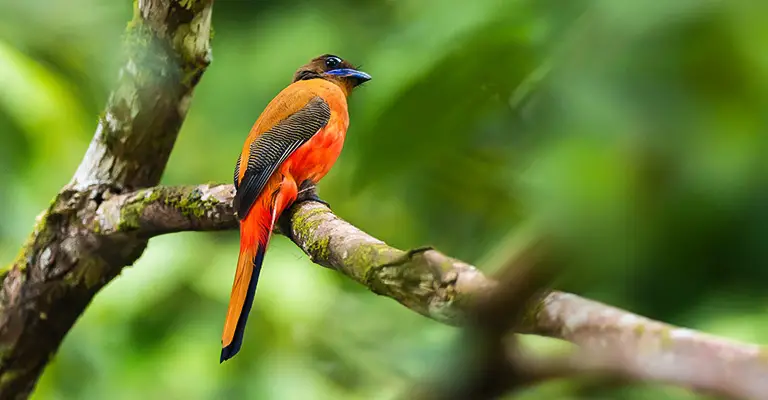
Trogons belong to the Trogonidae family, with around 35 species mainly inhabiting tropical and subtropical forests. Characterized by plumage, males exhibit metallic greens and reds, while females display duller hues.
Their unique heterodactyl toe arrangement aids in their arboreal lifestyle. Relying heavily on woodpeckers, they typically nest in tree cavities.
In their diet, insects and fruits feature prominently. Among the species, the Elegant Trogon is found in the southwestern U.S. and Central America.
Scientific classification:
| Kingdom | Animalia |
| Phylum | Chordata |
| Class | Aves |
| Clade | Cavitaves |
| Clade | Eucavitaves |
| Order | Trogoniformes AOU, 1886 |
| Family | Trogonidae Lesson, 1828 |
Also Featured In: Rainforest Birds You Should Know, Birds that Live in Guyana
42. Plain Bush-Hen
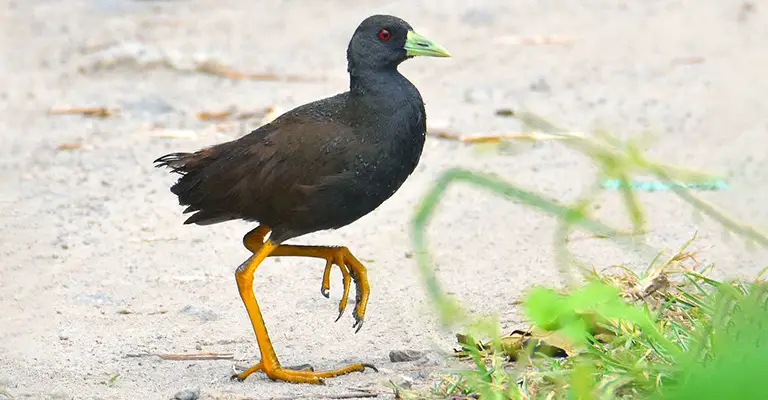
The Plain Bush Hen is a large bird native to Luzon in the Philippines. It thrives in swampy grasslands and forest edges near water.
With a slate gray head and underparts, it transitions to a brown back and tail. Its greenish yellow legs and thick bill stand out. This bird’s vocal nature makes it more often heard than seen, producing rhythmic quacking sounds.
Scientific classification:
| Kingdom | Animalia |
| Phylum | Chordata |
| Class | Aves |
| Order | Gruiformes |
| Family | Rallidae |
| Genus | Amaurornis |
| Species | A. olivacea |
43. Brown-Banded Rail
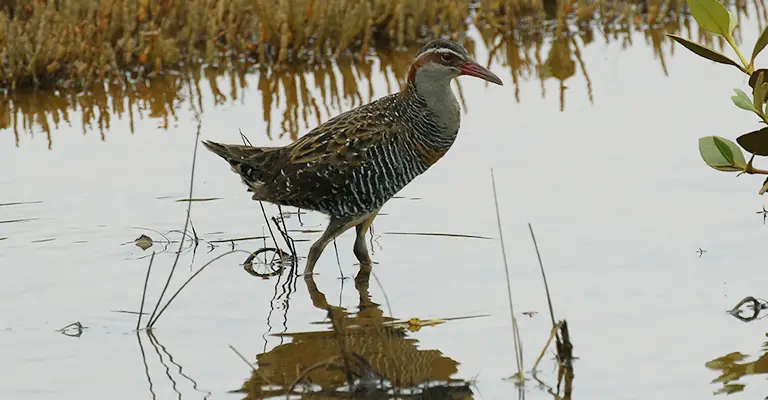
The Brown Banded Rail, known scientifically as Lewinia mirifica, resides in the Philippines, predominantly on Luzon.
This medium-sized bird favors cloud forests and undisturbed river swamps at 500 to 2,250 meters elevation.
Sporting dark brown plumage and a pale gray chest, it displays a reddish bill. Although elusive, it likely relies on earthworms and arthropods for sustenance. Threats include hunting and habitat loss, yet its conservation status remains data deficient.
Scientific classification:
| Kingdom | Animalia |
| Phylum | Chordata |
| Class | Aves |
| Order | Gruiformes |
| Family | Rallidae |
| Genus | Lewinia |
| Species | L. mirifica |
44. Spotted Wood Kingfisher
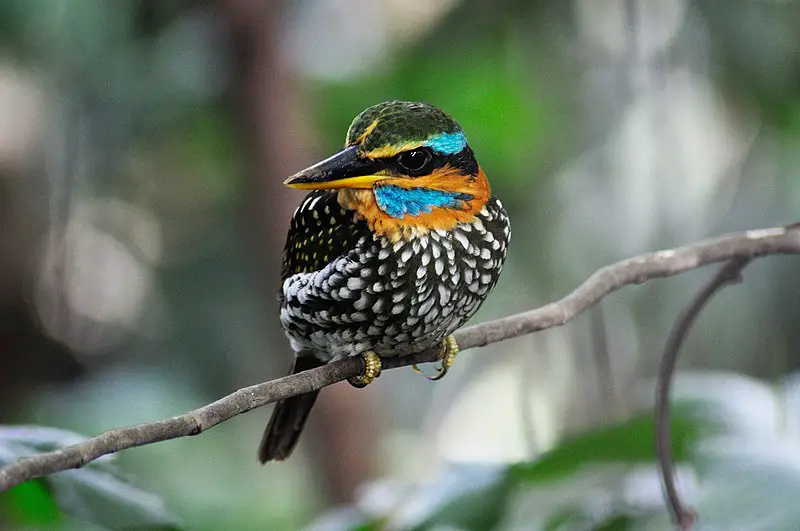
The Spotted Wood Kingfisher, endemic to the Philippines, brightens the islands of Luzon, Catanduanes, Marinduque, Negros, and Panay.
It measures about 26 cm and features a dark green crown with black spots. This species thrives in moist lowland forests, mostly hidden due to its dense habitat preference.
It feeds on insects and small vertebrates. Although listed as Least Concern, habitat destruction remains a threat.
Scientific classification:
| Kingdom | Animalia |
| Phylum | Chordata |
| Class | Aves |
| Order | Coraciiformes |
| Family | Alcedinidae |
| Subfamily | Halcyoninae |
| Genus | Actenoides |
| Species | A. lindsayi |
45. Gruiformes
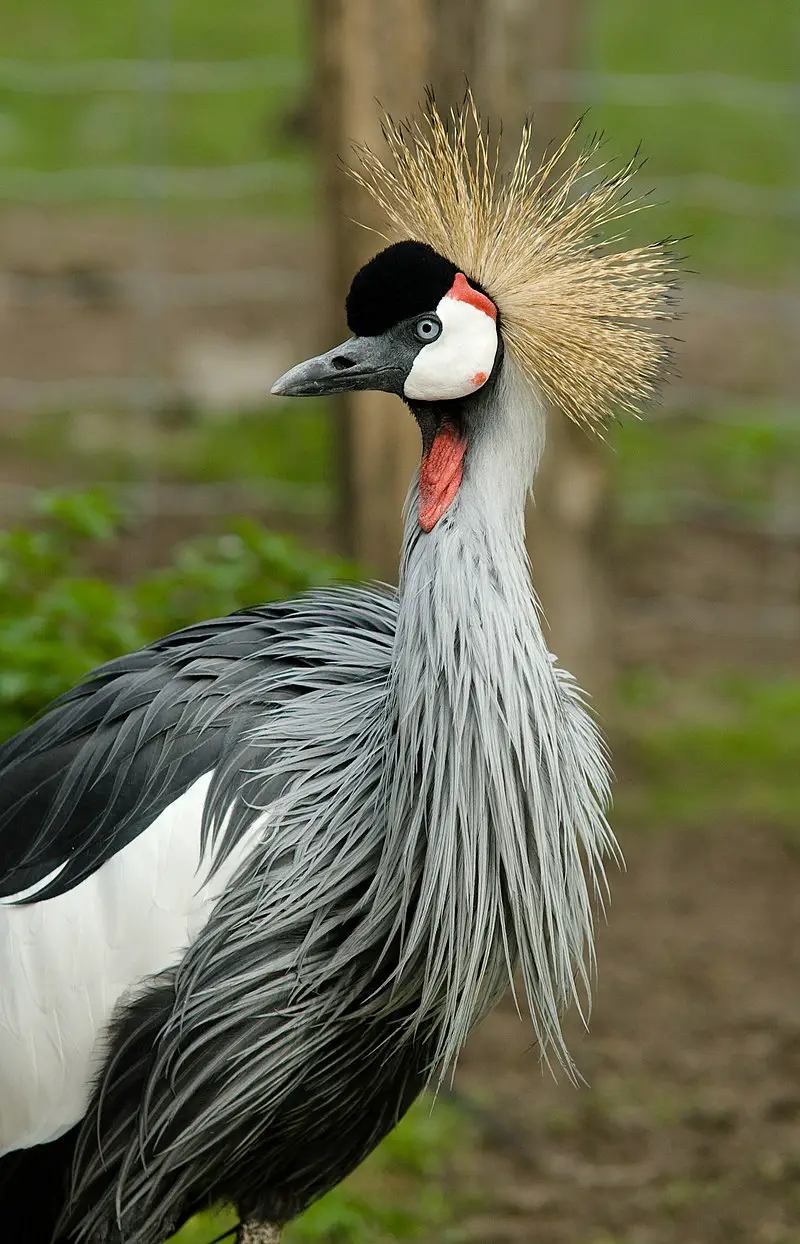
Gruiformes includes a variety of bird families like cranes and rails. These birds, found in diverse habitats such as wetlands and forests, number over 160 species.
Many, like the sarus crane, face threats due to habitat loss. They exhibit unique behaviors like elaborate courtship dances, making them fascinating to observe.
Their size ranges from small button quails to large cranes, displaying significant diversity within the order.
Scientific classification:
| Kingdom | Animalia |
| Phylum | Chordata |
| Class | Aves |
| Clade | Gruimorphae |
| Order | Gruiformes Bonaparte, 1854 |
46. Negros Bleeding-Heart Pigeon
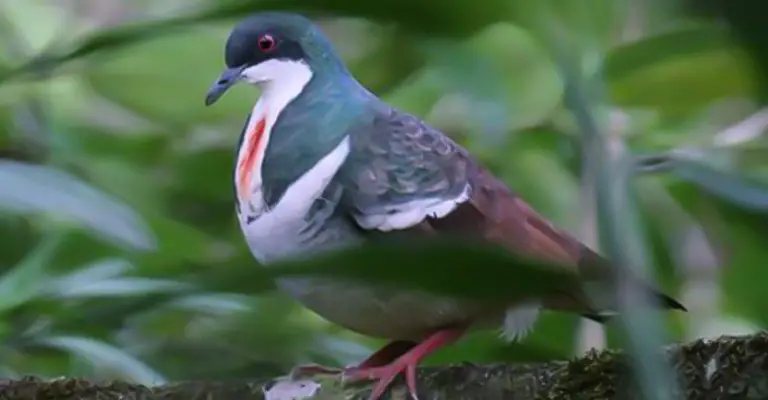
The Negros Bleeding-Heart Pigeon, primarily found on Negros and Panay islands, features exceptional plumage with a distinct red chest patch.
Measuring about 25 cm, this critically endangered bird sees a fragmented population of only 50 to 249 mature individuals.
Habitat loss due to deforestation and hunting severely threatens its existence. Conservation strategies, including captive breeding and habitat protection, aim to prevent extinction.
Scientific classification:
| Kingdom | Animalia |
| Phylum | Chordata |
| Class | Aves |
| Order | Columbiformes |
| Family | Columbidae |
| Genus | Gallicolumba |
| Species | G. keayi |
47. Black-Chinned Fruit Dove
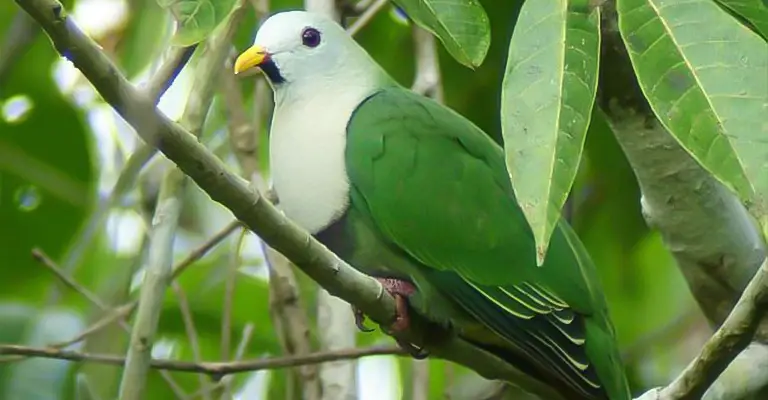
The Black-Chinned Fruit Dove, also known as the Black-Throated Fruit Dove, belongs to the Columbidae family. This medium-sized bird grows up to 27 cm in length.
Males stand out with a green belly, brown tail, and a unique whitish-gray head with a purple base. In contrast, females have a more uniform green color. They inhabit lowland forests in the Philippines and Taiwan.
Scientific classification:
| Kingdom | Animalia |
| Phylum | Chordata |
| Class | Aves |
| Order | Columbiformes |
| Family | Columbidae |
| Genus | Ptilinopus |
| Species | P. leclancheri |
Also Featured In: Most Common Birds of Lubang Island,
48. Phasianidae
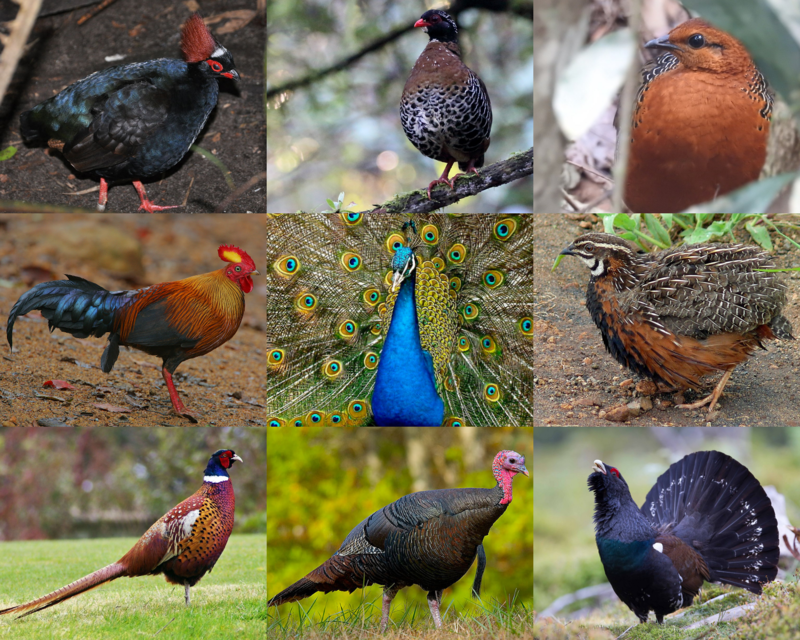
The Phasianidae family includes heavy, ground-dwelling birds like pheasants and quail. In the Philippines, partridges are particularly notable.
These birds are robust, with stout bodies, short wings, and powerful legs. Its plumage often adorns the males, who engage in elaborate courtship displays.
Conservation is critical due to habitat loss and hunting pressures. The diversity within this family highlights their ecological importance.
Scientific classification:
| Kingdom | Animalia |
| Phylum | Chordata |
| Class | Aves |
| Order | Galliformes |
| Superfamily | Phasianoidea |
| Family | Phasianidae Horsfield, 1821 |
49. Palawan Hornbill
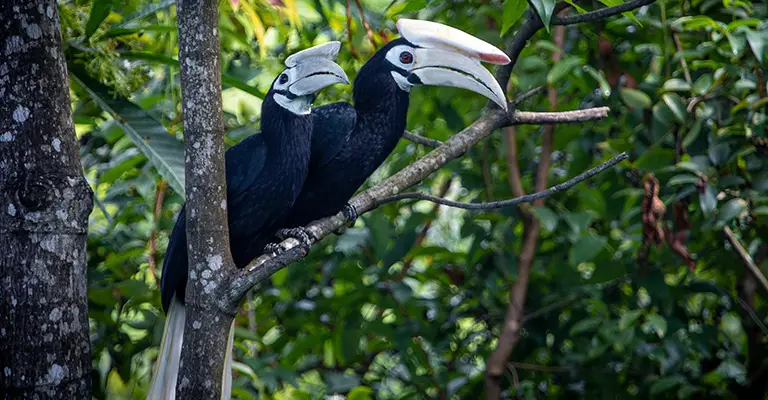
Palawan Hornbill, a striking bird endemic to the Philippines, measures about 70 cm. Its all-black plumage, white tail, and prominent pale cream-colored bill set it apart.
Males are larger, showcasing sexual dimorphism in bill size. Typically inhabiting lowland forests, they predominantly eat fruits, aiding seed dispersal.
Their vulnerable status stems from habitat loss due to deforestation and hunting, highlighting ongoing conservation efforts to protect this unique species.
Scientific classification:
| Kingdom | Animalia |
| Phylum | Chordata |
| Class | Aves |
| Order | Bucerotiformes |
| Family | Bucerotidae |
| Genus | Anthracoceros |
| Species | A. marchei |
50. Treeswift
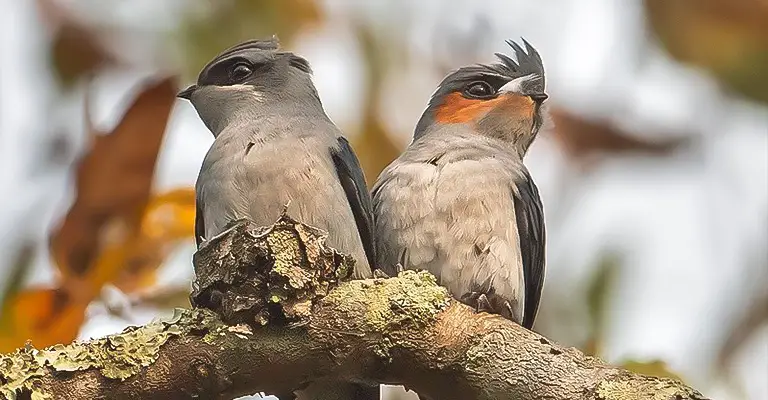
Treeswifts belong to the family Hemiprocnidae and are found in the Oriental region’s tropical forests, ranging from India to the Solomon Islands.
With ornately crested plumage and bold striping, they exhibit a distinct appearance compared to true swifts.
These birds measure between 15 and 31 cm, featuring long forked tails and broad gapes for catching insects.
They are monogamous, with both parents contributing to raising young in tree canopy nests. Habitat destruction threatens their varied conservation status.
Scientific classification:
| Kingdom | Animalia |
| Phylum | Chordata |
| Class | Aves |
| Order | Apodiformes |
| Family | Hemiprocnidae Oberholser, 1906 |
| Genus | Hemiprocne Nitzsch, 1829 |
Also Featured In: Birds that Live in Tamil Nadu,
Conclusion
The Philippines’ avian diversity is a testament to its rich natural heritage, offering bird enthusiasts a unique glimpse into the wonders of the avian world.
While these birds captivate with their plumage and intriguing behaviors, they face significant threats from habitat loss and human activities.
Conservation efforts are paramount in ensuring these species thrive for future generations. By raising awareness and promoting sustainable practices, there’s hope for preserving the remarkable biodiversity that defines the Philippines.
Birdwatchers and conservationists alike are encouraged to continue exploring and protecting these avian treasures, ensuring their survival and the ecological balance they support.